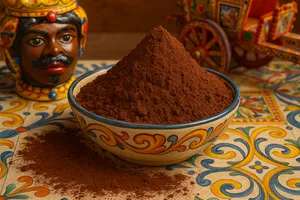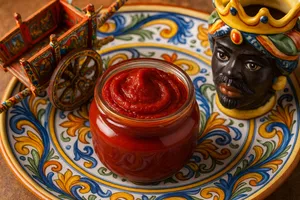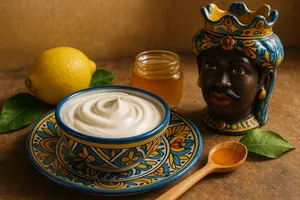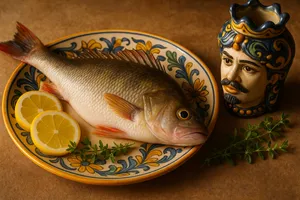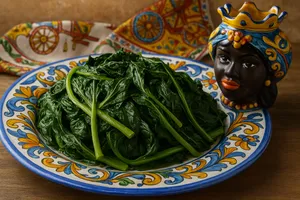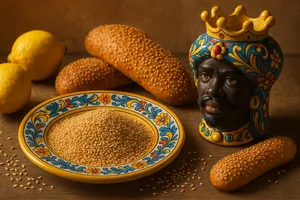Overview
Jam is made by slowly cooking fruit with sugar, a process that preserves fruit far beyond its natural season and produces a sweet, spreadable, long-lasting conserve. This age-old preservation technique, perfected over centuries, allowed Sicilian families to enjoy the flavours of summer even in winter, symbolising domestic abundance and foresight.
In Sicilian tradition, jam-making was an important seasonal ritual involving the whole family. When fruit ripened in abundance, it was turned into jam and stored in glass jars, later lined up in the pantry as precious reserves. Every family had its own recipes passed down through generations, with secrets for achieving the perfect consistency and the right balance of sweetness and acidity. The most traditional Sicilian jams are citrus-based (especially bitter orange), as well as fig, apricot, peach, and quince, but any fruit could be preserved. Today, jam remains a staple of Sicilian breakfasts and pastry-making, used to fill biscuits, tarts, and cakes, and to accompany cheeses.
Characteristics
Jam is dense and spreadable, with colour varying by fruit: orange for oranges, red for strawberries, deep purple for figs, golden yellow for apricots. Texture ranges from soft and creamy to more solid and gelled, with fruit pieces of varying size depending on the recipe.
The flavour is sweet with the distinctive notes of the original fruit, balanced by a slight acidity that enhances taste. The aroma is intense and fruity, especially noticeable when the jar is first opened. A good jam preserves the colour, aroma, and flavour of fresh fruit, concentrated yet recognisable.
The ideal consistency is firm enough to sit on a spoon but soft enough to spread easily — not too runny, nor overly solid or crystallised. Colour should be bright, not dull or overly darkened by excessive cooking.
Difference between jam, preserve, and fruit spread
European regulations define specific differences:
Jam: Produced exclusively from citrus fruits (oranges, lemons, mandarins, grapefruits), containing at least 20% fruit. The name derives from the Portuguese “marmelo” (quince), though today it refers specifically to citrus preserves.
Preserve (confettura): Made from any other fruit (strawberries, apricots, peaches, etc.), containing at least 35% fruit (45% for “extra” preserve). What is commonly called “strawberry jam” is technically a preserve.
Fruit spread (composta): Contains more fruit (usually over 60%) and less sugar, with a softer, less gelled texture. It has a shorter shelf life.
In everyday Sicilian speech, however, “marmellata” refers to any sweet fruit conserve, regardless of the technical distinction.
Traditional Sicilian jams
Bitter orange jam
The most classic Sicilian jam, made with bitter oranges (melangolo) that grow widely on the island. It has a distinctive sweet-bitter flavour, intense orange colour, and is used for breakfast and pastry fillings. This is the only true “marmellata” in the legal sense.
Fig preserve
Made with summer black or green figs. Deep purple in colour with an intense sweet flavour and dense texture dotted with crunchy seeds. Excellent with cheeses as well as in sweets.
Apricot preserve
Bright orange, delicate, and versatile. Commonly used to fill tarts (the classic apricot tart), biscuits, and sweet pastries.
Peach preserve
Prepared with ripe summer peaches, golden-orange in colour with a fragrant sweet flavour. Ideal for breakfast or fillings.
Quince paste (cotognata)
A very dense, almost solid preparation made by cooking quince with sugar for a long time. It is cut into slices or cubes and eaten as a sweet or with cheese. A traditional speciality especially popular in inland Sicily.
Green tomato conserve
A unique sweet preserve made with end-of-season green tomatoes cooked with sugar, lemon, and spices. It is used particularly in traditional Christmas pastries such as buccellati.
Traditional preparation
Homemade jam follows a well-established process:
1. Selecting the fruit: Use ripe but firm fruit, free of bruises or rot. Quality fruit equals quality jam.
2. Preparation: Wash the fruit thoroughly, remove skin, pits, and seeds if necessary, and cut into pieces. For citrus, the peel is included.
3. Cooking: Cook the fruit in a large pot (traditionally copper, which conducts heat well) with sugar in a proportion of about 1:1 or less (500–800g of sugar per 1kg of fruit depending on sweetness). Add lemon juice, which aids gel formation thanks to natural pectin and balances sweetness.
4. Stirring: Cook for 30–60 minutes or more, stirring regularly to prevent sticking. Skim off any foam that forms.
5. Gel test: Drop a small amount on a cold plate: if it thickens and doesn’t run when the plate is tilted, it’s ready.
6. Jarring: Pour the hot jam into sterilised glass jars, filling to 1cm below the rim. Close immediately with sterilised lids.
7. Sealing: Flip jars upside down briefly (traditional method) or boil them in water for 15–20 minutes. Cooling creates the vacuum seal needed for preservation.
The role of sugar and pectin
Sugar plays three essential roles: it preserves (high sugar concentration prevents bacterial growth), sweetens, and works with pectin to form the gel. Sugar quantity affects flavour and shelf life: less sugar means a less sweet jam but also one that does not keep as long.
Pectin is naturally present in fruit and responsible for gelling. Fruits high in pectin (citrus, quince, apples, currants) gel easily. Low-pectin fruits (strawberries, peaches, apricots) need added lemon juice or apples, or commercial pectin.
Traditional recipes rely on natural pectin, sometimes adding apple or lemon peels during cooking (later removed).
Culinary uses
Jam is widely used in Sicilian cuisine.
Breakfast
Spread on bread, toast, or rusks, often accompanied by butter or ricotta. The most traditional use.
Tarts
Jam tarts are a classic Sicilian home dessert: shortcrust pastry filled with jam (typically apricot or peach) and decorated with lattice strips.
Biscuits
Many traditional Sicilian biscuits use jam: thumbprint cookies, filled biscuits, almond pastries with jam centres.
Traditional desserts
Jam or green tomato conserve is used in Christmas buccellati—ring-shaped or braided pastries typical of the holiday season.
Cheese pairing
Fig, citrus, or quince jams pair wonderfully with aged or fresh cheeses, offering pleasant flavour contrasts.
Semifreddi and gelato
Jam is used as a filling or topping for semifreddi, parfaits, and as a swirl in artisanal gelato.
Cake glazing
Warm, diluted apricot jam is brushed onto cakes to give shine and set decorations.
Storage
Vacuum-sealed jars keep at room temperature in a cool, dark, dry place for 12–24 months. The seal must be intact: the lid should not “click” when pressed.
Once opened, keep refrigerated and consume within 3–4 weeks. Always use clean spoons to prevent contamination and mould.
If mould appears, discard the entire jar. Though some grandmothers scraped off the top layer, modern food safety guidelines advise against it.
Buying tips
When buying packaged jam, check:
- Fruit content: more is better; look for “extra preserve” with at least 45% fruit.
- Ingredients: ideally just fruit, sugar, lemon juice. Avoid glucose syrup, artificial thickeners, preservatives, colourings.
- Sugar content: “light” versions have less sugar but often more additives.
- Origin: prefer artisanal Sicilian products made with local fruit.
- Appearance: look for bright colour, no excessive crystallisation or liquid separation.
Artisanal jams are generally superior to industrial ones in fruit quality, flavour authenticity, and absence of additives. The higher price reflects this quality.
Homemade jam
Making jam at home allows full control of ingredients and sweetness, uses seasonal fruit at peak ripeness, enables creative combinations, avoids additives, saves money when fruit is abundant, and preserves a cherished tradition. It requires time, care, and proper equipment (large pots, long spoons, sterilised jars), but the result is rewarding. Many Sicilian families still dedicate summer days to making preserves.
Common issues and solutions
Jam too runny: Under-cooked or low-pectin fruit. Solution: cook longer or add lemon juice/pectin.
Jam too firm: Overcooked or too much sugar. Thin by reheating with a little water.
Crystallisation: Excess sugar or overcooking. Fix by gently reheating with a bit of water.
Mould after opening: Contamination or improper storage. Prevent by using clean utensils and refrigerating.
Poor vacuum seal: Improper sterilisation or insufficient filling. Consume immediately or re-pasteurise.
Nutritional properties
Jam is calorie-dense: about 250–280 calories per 100g, mainly from sugars (60–70g). Even “extra” preserves contain more sugar than fruit.
Most vitamins are lost during long cooking, especially heat-sensitive vitamin C. Some minerals and small amounts of fibre remain. Nutritionally, jam is essentially sugar flavoured with fruit.
It should be consumed in moderation, as an accompaniment or ingredient rather than as a fruit substitute. A reasonable portion is 1–2 teaspoons (10–20g).
Curiosities
Jam has ancient origins. Greeks and Romans preserved fruit with honey. Techniques evolved with the arrival of sugar in medieval Europe, making jam a luxury available only to the wealthy.
Bitter orange marmalade has a curious history: according to legend, a ship carrying bitter oranges—too bitter to eat fresh—arrived in a Scottish port. A local grocer bought them cheaply, and his wife cooked them with sugar, discovering that heat and sugar transformed them into a delicious preserve. Thus the famous British “marmalade” was born.
In Sicily, the abundance of citrus made orange jam particularly popular. Bitter oranges (melangolo), also used to produce orange blossom water, became precious ingredients for preserves.
A Sicilian saying goes: “Casa ca nn'avi marmillata, casa ca nn'avi nenti” (“A house without jam is a house without anything”), highlighting how jars of jam symbolised foresight, wealth, and good housekeeping.
During wartime and the post-war period, when sugar was rationed, jam-making became challenging. Some families reduced sugar and compensated by longer cooking; others added prickly pear or carob juice, naturally rich in sugars.
Quince paste, a very firm jam, was considered a refined sweet. It was cut into geometric shapes, skewered with toothpicks, and served to guests alongside fresh water or sweet wine.
In rural Sicilian families, there was a tradition of “shared preserves”: when fruit was abundant, neighbourhood women gathered to prepare large quantities of jam together, later divided equally. It was a moment of community, recipe swapping, singing, and conversation, strengthening social ties.




